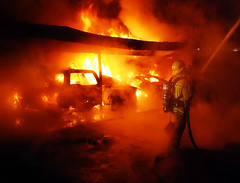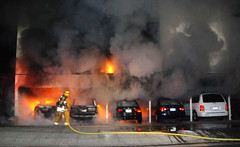1. The Death of Al Davis
When Davis died Oct. 8, at age 82, it left obituary writers scrambling for ways to sum up a man who not only was the face of the Raiders franchise but also its heart, its brains and its combative personality.
The Raiders themselves took their best crack on the day Davis died, describing their patriarch as "unique -- a maverick, a giant among giants, a true legend among legends, the brightest star among stars, a hero, a mentor, a friend."
Davis spent 48 years defining the franchise, as a coach, as general manager and, most famously, as an owner. He controlled everything, right down to the team colors. (Davis picked silver and black because he thought it would look intimidating.)
Stocked with misfits that only Davis and his fans would love, the Raiders went 372-219-11 and won three Super Bowls from 1963 through 2002.
By the time Davis died, his team hadn't finished with a winning record in its past eight seasons. But this year's Raiders are within reach of a playoff spot, buoyed by the audacious trade for quarterback Carson Palmer, a deal that coach Hue Jackson said his old boss would have loved.
As Raiders safety Michael Huff said when the Raiders beat Houston less than 24 hours after Davis' death: "He's never gone in our eyes. We'll never let him go. He's with us."
2. Harbaugh leads 49ers resurgence
A division title. An invigorating new coach. A new stadium on the way. This was the year in which a long-dormant dynasty came roaring back to life.
The 49ers are 12-3 behind a top-ranked defense that could have them playing deep into January.
Team president Jed York hired Jim Harbaugh as his coach and Trent Baalke as his general manager in January, and the 49ers have done nothing but press the right buttons since.
The list of transformative feats includes a sensational first-round draft pick (sack-machine Aldon Smith), a wave of bargain free agents (kicker David Akers, defensive back Carlos Rogers, safety Donte Whitner) and a surprisingly solid season from quarterback Alex Smith.
Summing up Harbaugh's impact, 49ers Hall of Famer Ronnie Lott told Sirius XM radio that "this might be the greatest coaching that I've ever seen in the history of the game of professional football."
3. Buster Posey busted at home plate
Scott Cousins didn't slide, but the Giants sure did. They were 21/2 games up in the National League West on May 25 when Cousins, the nicest villain you will ever meet, blasted into Buster Posey in a home-plate collision.
A broken bone in his lower left leg and three torn ligaments in his ankle cost the star catcher the remainder of the season.
The defending World Series champs never recovered, finishing last in the National League with a .303 on-base percentage.
"If I never hear from Cousins again, or he doesn't play another day in the big leagues, I think we'll all be happy," general manager Brian Sabean told KNBR in June. (Sabean has since reached out to apologize.)
Major League Baseball officials deemed it a clean play and have resisted the Giants' pleas for a rule change to protect catchers from being targeted in home-plate collisions.
4. Andrew Luck stays in school
Andrew Luck had an opportunity to take the money and run. Instead, he passed.
The quarterback delayed entry into the NFL so that he could keep Stanford humming as a national power. And Luck delivered as hoped, leading the Cardinal (11-1) to a No. 4 national ranking and a Fiesta Bowl showdown against No. 3 Oklahoma State (11-1)
For the picky, there was a whiff of disappointment: He threw two interceptions in a loss to Oregon that dashed Stanford's hope of a national title and sank Luck's chances of a Heisman Trophy (he was the runner-up again).
But he mostly flourished, securing Stanford career records for passing touchdowns (80) and passing efficiency (161.7), among legions of other records.
The NFL won't have to wait much longer. Luck is expected to be the No. 1 pick in the April draft.
5. Giants oust owner Bill Neukom
In the span of less than a year, Bill Neukom went from waving in a victory parade to waving goodbye.
The Giants' managing general partner and chief executive officer was ousted after an apparent series of disagreements with the 10-member executive committee.
This newspaper broke the news of the shake-up in September, less than 11 months after Neukom hoisted the first World Series trophy in the Giants' 53 years in San Francisco.
In the wake of the report, the Giants announced that Neukom would "retire from his position effective Dec. 31," with Larry Baer taking over CEO duties.
Baseball sources said Neukom's falling out with the executive committee stemmed from how to divvy up the additional millions of dollars that flowed into team coffers after the World Series championship.
6. The Warriors rebuild with splashy names
Though NBA action was disrupted by a labor dispute, Warriors ownership still managed to treat 2011 like one long fast break. New managing partners Joe Lacob and Peter Guber restructured the basketball operations staff, replaced an entire coaching staff and made several changes at the executive level on the business side.
Needing help, ownership also added two men with a combined 16,000 assists. They hired Jerry West, the Hall of Famer and respected front-office architect, in May and added former All-Star guard Mark Jackson as their coach weeks later.
"I fully expect, put it in bold letters, the Golden State Warriors to be a playoff team next year," Jackson said. "If I did not expect that, I would not have taken the job. ... We are looking to turn the Bay Area upside down."
7. The saga of Bryan Stow
In a horrific chapter to a storied sports rivalry, Giants fan Bryan Stow was punched in the head, kicked and slammed to the ground outside Dodger Stadium in March.
"It brings tears to my eyes," longtime Dodgers manager Tommy Lasorda said, reacting to the news. "This is not what baseball is all about."
Stow, a paramedic and father of two young children, spent months in a medically induced coma and only recently became able to hold a simple conversation. He is fed by a tube and needs round-the-clock care. Stow, 43, is expected to be permanently disabled.
8. Cal sports make a comeback
Giving new meaning to the term elimination games, the Cal baseball team rallied back from an incredible deficit -- as in $10 million.
The Bears athletic department had announced in the fall of 2010 that it was cutting four sports and reclassifying men's ruby as a varsity club sport as a drastic move to bridge a budget shortfall.
But the endangered Bears rallied. Chancellor Robert J. Birgeneau announced in February that enough money had been raised to keep rugby, women's lacrosse, women's gymnastics and men's gymnastics.
The comeback was complete April 8, when Cal announced that baseball would be saved thanks to the former players and alumni who generated $9 million in financial commitments.
Instead of going extinct, the Bears rolled all the way to the College World Series. "A wild ride," coach David Esquer called it.
9. Sharks bounced short of the Cup
Even for fans accustomed to coming up short, this one was tough to take. A freakish bounce off a stanchion finished the Sharks' title hopes May 24, when Vancouver's Kevin Bieksa scored a strange and fortuitous goal during the second overtime of Game 5 of the Western Conference finals.
As Bieksa screamed in delight, almost everybody else was still looking for the puck.
"It came right to Bieksa. One more bounce he probably whiffs on it, we're still playing. Nothing we can do about it," Sharks coach Todd McLellan said after the game.
10. Stanford women win first soccer title
With one last spectacular goal, the seniors on the Stanford women's team secured the status as one of the greatest classes in college soccer history.
The Cardinal beat Duke 1-0 in the College Cup final Dec. 4, capping a 95-4-4 record for a senior class and easing the pain from losses in the previous two national title games.
Camille Levin delivered a cross to Teresa Noyola for a point-blank header in the 53rd minute.
"I've never seen a team work so hard for each other and want to win for each other," Levin said. "I've never played on a team like that in my life."
Also receiving consideration: "Moneyball" movie fares better than current A's; Kelly Slater wins 11th surf title at Ocean Beach; Barry Bonds sentenced to 30 days' house arrest, pending appeal; Chris Mullin and Tara VanDerveer inducted into Basketball Hall of Fame; Stanford women's basketball team makes fourth consecutive Final Four; Tiger Woods helps lure record crowds to Frys.com Open; America's Cup awarded to San Francisco for 2013.
Article any source



























